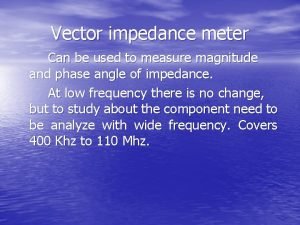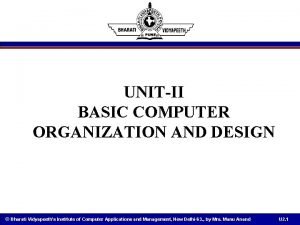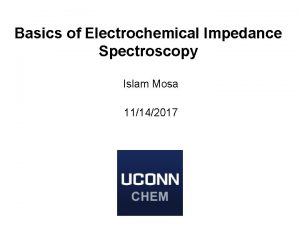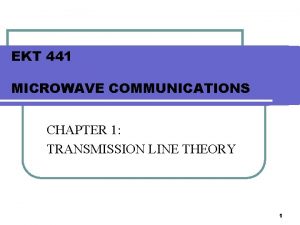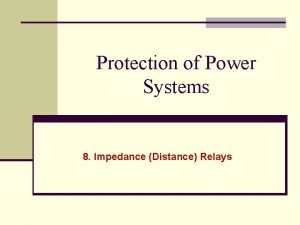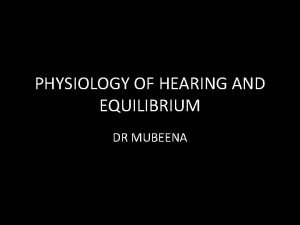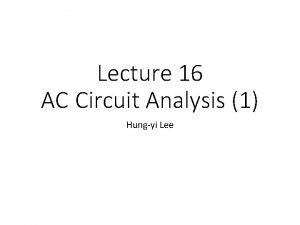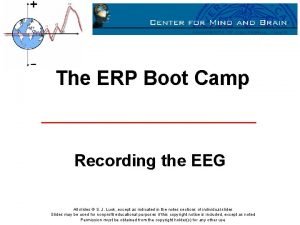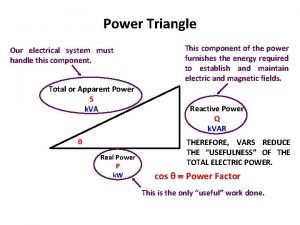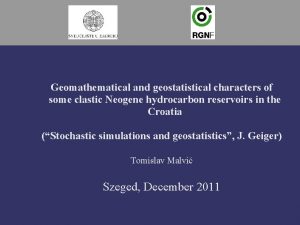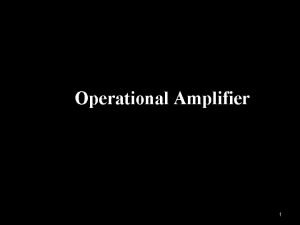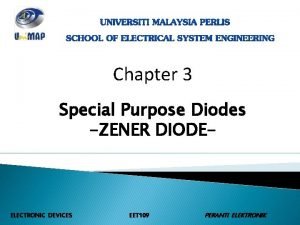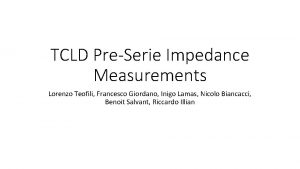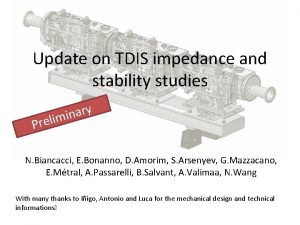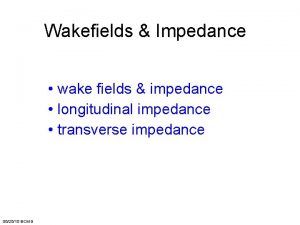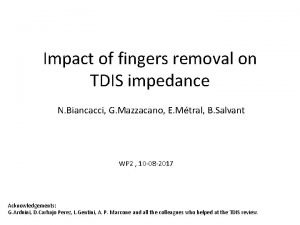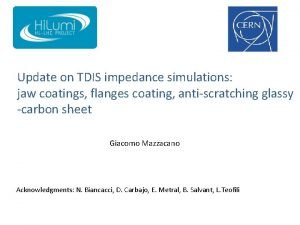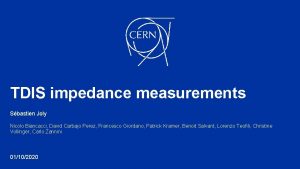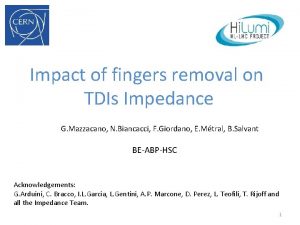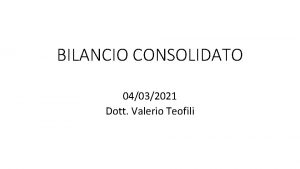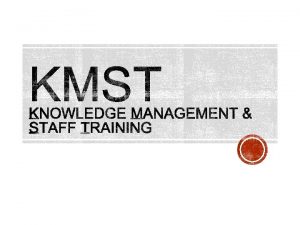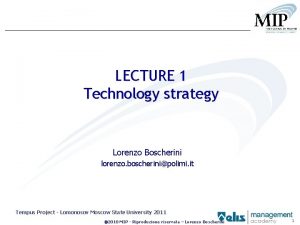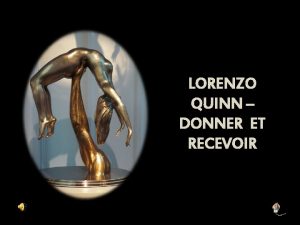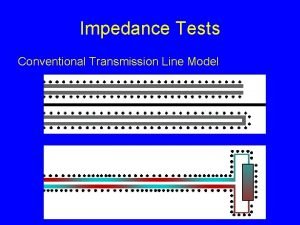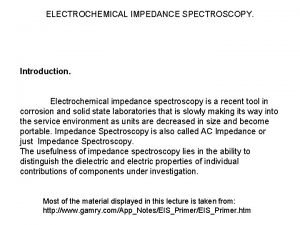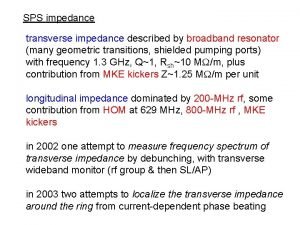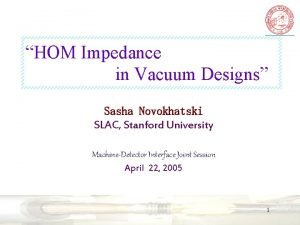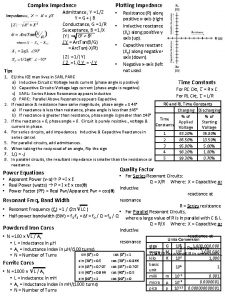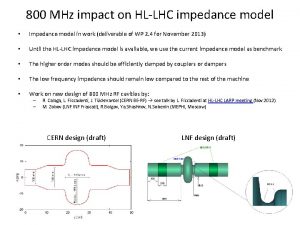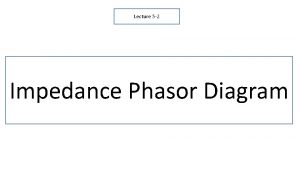Updated impedance studies for the TDIS Lorenzo Teofili















![The 3 D RF-heating Map Impedance RF-Heating Heat Flux [W/m^2] Upper Jaw Lower Jaw The 3 D RF-heating Map Impedance RF-Heating Heat Flux [W/m^2] Upper Jaw Lower Jaw](https://slidetodoc.com/presentation_image_h/21aae182d33565f1fe72545d1d817c7a/image-16.jpg)














- Slides: 30

Updated impedance studies for the TDIS Lorenzo Teofili, David Carbajo, Francesco Giordano, Inigo Lamas, Giacomo Mazzacano, Benoit Salvant 06/07/2018 WP 14 Coordination Meeting: TDIS

Scope Of the Presentation • Introduce the model geometry and the CST simplifications • Simulation Results • Electromagnetic • Nominal Scenarios vs RF-Finger Failure Scenarios • Impact of the Carbon Sheet Plate • Thermomechanical • RF-Heating 3 D Map • Temperature and Stresses • Next Step: The Two Counter-Rotating Beams Problem 2

Model Geometry and CST Simplifications Top: The TDIS model for production, general overview and detail: front view cut with main parts labeled, RF-finger system. Bottom Left: The CST simplified model, only the features important for the electromagnetic simulations have been preserved. 3

Impedance Simulations: Two Possible Scenarios • Nominal Scenarios In this scenario the longitudinal RF-contact are considered, i. e. the electrical contacts between the segments is guaranteed and the image currents can smoothly flow in the device. Lateral Curved RF-Shielding Longitudinal RF-Contacts Graphite Block • RF-Finger Failure Scenarios (Pessimistic Scenario) In this scenario the longitudinal RF-contact are NOT considered (they are present in the design and in the simulations but they do not physically touch the parts on one tip). There is not electrical contacts between the segments and the image currents cannot smoothly flow in the device. An higher Impedance is expected. Lateral Curved RF-Shielding Longitudinal RF-Contacts Graphite Block 4

Extra Comments • The presented simulations have been done with a half-gap aperture of the jaws of 5 mm instead of the current fixed value of 3. 8 mm. This is because at the time the simulations were run the half-gap data was not available yet and a tentative value was used. However, due to the small difference between the tentative value and the correct one small changes are expected in the electromagnetic behavior of the device. 5

Impedance Simulations: Two Possible Scenarios, General Overview Beam normalized spectrum (BNS) in black and longitudinal impedance real part in log scale, 5 mm half-gap (at injection). For the scenario with fingers, there are no trapped resonant modes inside the structure below 1. 25 GHz. Indeed, electric contacts prevent trapped modes below the cut-off frequency of the LHC pipe. In the scenario without RF fingers, several trapped modes are presents below 1. 25 GHz. This is a dangerous situation because at this frequency they could strongly couple with the beam. 6

Nominal Scenario: Different Gap Apertures Impedance worst case half gap: 5 mm No HOMs below 1. 25 GHz whatever the jaws aperture Good impedance behavior of the device! 7

Nominal Scenario: Imaginary Impedance for 5 mm half-gap. 2 milliohm at the flat part. 8

Impact of the anti-scratching glassycarbon sheet on Impedance Absorbing block • A glass-like carbon sheet would prevent the fingers from scratching the graphite block, UFO should be avoided • 2 mm thickness, 45 u. Ohm*m mm) (3 x 1565 gth 4. 7 m Active len Courtesy of D. Carbajo Glassy carbon sheet 0. 7 m Copper 0. 9 m Titanium Low Z jaws (2 blocks of graphite per jaw) 9

Longitudinal Impedance 5 mm Half-gap 10

Longitudinal Impedance 15 mm Half-gap 11

Longitudinal Impedance 55 mm Half-gap Consistent discrepancy to be further analyzed in eigenmode solutions 12

Thermomechanical Simulations The Electromagnetic Interactions between the beam and the TDIS cause an energy deposition on the device itself (RF-Heating). This can results in an uneven temperature increase with consequent mechanical stresses induced by thermal gradient. Since the TDIS predecessor, the TDI, has had severe issues probably due to the RFheating an accurate analysis of the impedance related thermal load has been performed. 13

RF-Heating On the TDIS in The Two Different Scenarios 15 mm half-gap 25 mm half-gap Courtesy of N. Biancacci • The worst case scenario: Failure of the fingers, half gap 5 mm, 1003 W dissipated Power in HOM and 800 W in Resistive wall Impedance (In case of NO finger failure 465 W dissipated because of HOMs and 800 W dissipated Because of resistive wall impedance) • Max and mean are related to the computation method, max is the worst case. 14

RF-Heating On the TDIS for the Finger Failure Scenario HOM, Different Half Gaps Each HOM is responsible for a different heating flux. In the figure above is reported the heating contribution of the HOMs in the TDIS for two different half-gap aperture of the jaws. In order to obtain the total heating flux in the device all the single HOM contribution have to be summed. • Half-gap 25 mm, total heating flux 798. 3 W • Half-gap 5 mm, total heating flux 1003 W Always considering a worst case scenario approach, the 5 mm case was considered for thermomechanical simulations. Furthermore, in this configuration also the resistive wall impedance heating contribution is the highest. 15
![The 3 D RFheating Map Impedance RFHeating Heat Flux Wm2 Upper Jaw Lower Jaw The 3 D RF-heating Map Impedance RF-Heating Heat Flux [W/m^2] Upper Jaw Lower Jaw](https://slidetodoc.com/presentation_image_h/21aae182d33565f1fe72545d1d817c7a/image-16.jpg)
The 3 D RF-heating Map Impedance RF-Heating Heat Flux [W/m^2] Upper Jaw Lower Jaw Latera Curved RFShielding A new method for mapping the HOM heating flux was developed and was applied to the TDIS. Above the Heating flux on the device is reported. The maximum Energy deposition is, as expected, on the gap between the segments. However, there is a non negligible heating flux on the RF-shielding. 16

The Thermo-Mechanical Simulations Scenarios Injection Case with RF-Finger Failure: • Jaws Half-gap 5 mm • Only The Injected beam has been considered • Maximum injection time 45 minutes Source Heat Load Affected [W] Element Secondary 580 Halos Jaws free surfaces Resistive Wall 798. 3 Jaws free surfaces HOM 1003. 6 Entire TDIS Lateral Curved RF-Shielding Lateral RF-Contacts Full-Gap Half-Gap Circulating Beam Lateral Straight RF-Shielding Injected Beam Backstiffener Jaw Free Surface 17

The thermos mechanical Simulations Results Lateral Curved RF-Shielding Lateral RF-Contacts Full-Gap Half-Gap Circulating Beam Lateral Straight RF-Shielding Injected Beam Backstiffner 18

The Thermo mechanical Simulations Results Lateral Curved RF-Shielding Lateral RF-Contacts Full-Gap Half-Gap Circulating Beam Lateral Straight RF-Shielding Injected Beam Backstiffner The maximum temperature is in the RF-fingers may deform the pieces, however this is not considered as a issues since the design allows for its free expansion. The maximum developed stresses in the lateral RF-shielding are not dangerous for the material. 19

Next Step: The Two Counter-Rotating Beams Problem Lateral RF-Contacts Half-Gap Circulating Beam Lateral Straight RF-Shielding Circulating Beam Full-Gap Injected Beam Lateral Curved RF-Shielding Injected Beam Back stiffener How the deposited energy in the device is affected? 20

Next Step: The Two Counter-Rotating Beams Problem • Phenomenon not fully understood. The pioneering study of C. Zannini, G. Rumolo and G. Iadarola (“Power loss calculation in separated and common beam chambers of the LHC”), who found a solution for a specific pipe geometry, seems to indicate an interference-like behavior of the RF deposited energy dependent on the time delay between the entrance of the first and the second beam in the device. • Thus, according to this result, the RF-heating load of two counterrotating beams in a worst case scenario could be up to 4 times the heat load induced in the same device by a single beam. • In order to benchmark this finding for more complex geometries a series of simulations have been carried out. The passage of two counter rotating beams in a cavity, both positioned exactly at the centre of the structure was modelled. 21

Preliminary Results from a Simple Model First Beam Second Beam 22

Preliminary Results from a Simple Model 23

Conclusions • The TDIS geometry and its simplifications for the electromagnetic and thermomechanical analysis have been presented • Electromagnetic Simulations: • Nominal configuration scenario ( No failure in the device). • Simulations showed a good electromagnetic behavior of the device that does not present any high order resonant electromagnetic modes below 1. 25 GHz. The analysis were repeated for different half-gap apertures and the results were positive in any case. • The effect of the RF-heating was investigated, 800 W are dissipated because of Resistive wall impedance and 500 W because of HOMs. • Failure Scenario ( Lost of contact by the longitudinal RF-Fingers ) • Simulations showed a bad electromagnetic behavior of the device. High order resonant electromagnetic modes are present below 1. 25 GHz. The analysis were repeated for different half-gap apertures with similar results. • The effect of the RF-heating was investigated, 800 W are dissipated because of Resistive wall impedance and 1003 W because of HOMs.

Conclusions • The impact of the anti-scratching glassy-carbon sheet on impedance was investigated. It improves the impedance performance of the device decreasing the shunt impedance of the HOMs • Thermo-mechanical Simulations. The worst case scenario for the energy deposited in the TDIS was considered: the pessimistic RFFinger Failure scenario with a jaws half-gap aperture of 5 mm. The heating source were Resistive wall impedance 800 W, HOMs 1003 W, Secondary Halos 580 W, total 2400 W. Despite the fact that our findings have highlighted some possible critical areas, neither the developed temperatures or the related mechanical stresses seems to be high enough to cause problems. • The Two Counter-Rotating Beams Problem. This is a possible issue in the TDIS. The phenomenon is not fully understood and further studies are ongoing to develop a physical model. 25

Thank You For Your Attention

Power Losses Computation N. Biancacci 27 27

The TDIS: Geometry, the RF-System Lateral Curved RF-Shielding Lateral RF-Contacts Full-Gap Half-Gap Circulating Beam Backstiffner Lateral Straight RF-Shielding Injected Beam Lateral Curved RF-Shielding Longitudinal GAP Longitudinal RF-Contacts Graphite Block 28

Longitudinal Fingers Lateral View Bottom View Top View 29

Extra Comments • The presented simulations have been done with an half-gap aperture of the jaws of 5 mm, considering only the injected beam passing between the jaws. Other half-gap apertures have been investigated (25 mm and 55 mm). However, the simulation results showed that the highest shunt impedances for the high order electromagnetic resonant modes are for the 5 mm half-gap value previously reported. 30
 Vector impedance meter block diagram
Vector impedance meter block diagram During _______ branching, only car is updated with adr
During _______ branching, only car is updated with adr Performance indicators formula deped
Performance indicators formula deped Paradigm shift from women studies to gender studies
Paradigm shift from women studies to gender studies Charge transfer resistance
Charge transfer resistance Presentera för publik crossboss
Presentera för publik crossboss Egg för emanuel
Egg för emanuel Svenskt ramverk för digital samverkan
Svenskt ramverk för digital samverkan Informationskartläggning
Informationskartläggning Myndigheten för delaktighet
Myndigheten för delaktighet Boverket ka
Boverket ka Borra hål för knoppar
Borra hål för knoppar Attenuation constant formula
Attenuation constant formula Impedance relay
Impedance relay Ledarskapsteorier
Ledarskapsteorier Densitet vatten
Densitet vatten Ministerstyre för och nackdelar
Ministerstyre för och nackdelar Macula in ear
Macula in ear Draw impedance triangle and show various quantities on it
Draw impedance triangle and show various quantities on it Verktyg för automatisering av utbetalningar
Verktyg för automatisering av utbetalningar Plagg i gamla rom
Plagg i gamla rom Skin electrode impedance
Skin electrode impedance Fimbrietratt
Fimbrietratt Power triangle
Power triangle Nyckelkompetenser för livslångt lärande
Nyckelkompetenser för livslångt lärande Acoustic impedance
Acoustic impedance Instagram
Instagram What is input impedance of op amp
What is input impedance of op amp Aktiv exspektans
Aktiv exspektans Zener diode example
Zener diode example Capacitor laplace
Capacitor laplace
